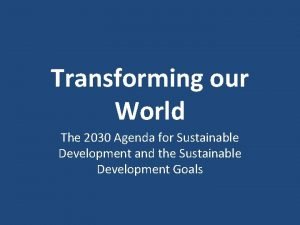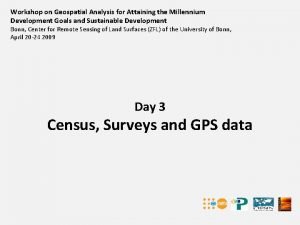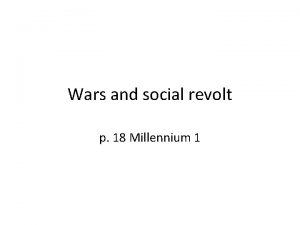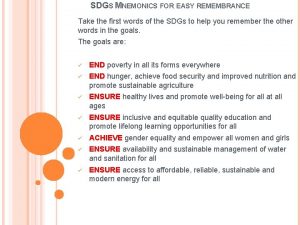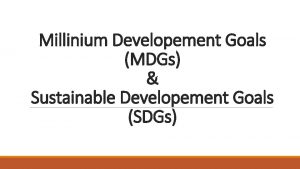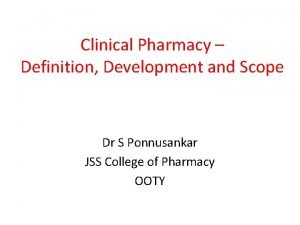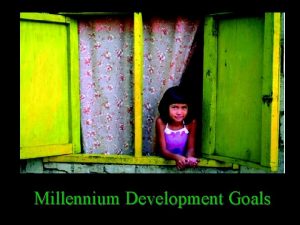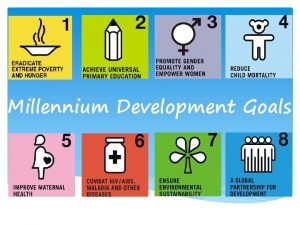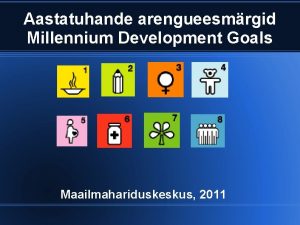Attaining the Millennium Development Goals in India How
















































- Slides: 48

Attaining the Millennium Development Goals in India: How Likely & What Will It Take?

Millennium Development Goals (MDGs) l As you all know, the MDGs are a set of numerical and time-bound targets to measure achievements in human and social development.


Five MDGs analyzed in this Report • Child and infant mortality reduction • Reduction in child malnutrition • Universal primary enrollment • Elimination of gender disparity in school enrollment • Reduction of hunger-poverty (calorie deficiency)

Limitations of much of the MDG discussion so far • Analysis has been at a highly aggregate level – typically the level of the country. This is meaningless in a large and heterogeneous country like India. • The likelihood of attaining the MDGs hasn’t been usefully linked to the factors that influence MD indicators. This is necessary to address the question: what will it take to attain the MDGs?

MDG Attainment in the Poor States of India l The poorest states in India (e. g. , Uttar Pradesh, Bihar, Rajasthan, Orissa, and Madhya Pradesh): • are among the most populous in the country, and • have among the worst MD indicators. l Owing to more rapid population growth, these states will account for an even larger share of India’s population in 2015. l Therefore, India’s attainment of MDGs will largely depend on the performance of these states.

Tremendous spatial variation in levels of & changes in MD indicators l There are very large inter-state and intra-state variations in all MD indicators in India. For instance, the IMR for the country is 66 infant deaths per 1, 000 live births. But it varies from a figure of 11 in Kerala to 90 in Orissa. l Intra-state variations in infant mortality and in primary school enrollment rates are even greater, as seen in the following map.

Infant Mortality Rate, 1997 -99

Net primary enrollment rates also vary a great deal across regions …

And there is a great deal intrastate variation in IMR decline as well, with some regions showing …

… as in changes in net primary enrollments.

Geographic Concentration of MD indicators l The wide disparity in MD indicators results in the geographical distribution of these indicators being heavily concentrated. l This indicates the need for targeting MDGrelated interventions to poorly-performing states, districts, and perhaps even villages (if these could be identified).

Case of infant mortality – Four states Uttar Pradesh l Madhya Pradesh l Bihar l Rajasthan – Account for more than 50% of infant mortality in India – Four more states account for another 21%, or a cumulative 72% l

51% 21%

l Infant deaths are even more concentrated at the district and the village levels.

Only one-fifth of the districts and villages in the country account for one-half of all infant deaths…

… and more than half of all underweight children are found in only a quarter of all villages and districts in the country.

Out-of-school children are even more concentrated. Nearly three-quarters of all out-of-school children in the country are found in a mere 20% of villages (and 50% of districts).

Identification of villages with poor MD indicators Unfortunately, currently-available data cannot allow identification of specific villages that account for most of the infant deaths, underweight children, or out-of-school children in the country, because most sample surveys are not large or representative enough at the village level. l But new, emerging methodologies are available to do this. l

Most Deprived Regions in India But we can identify the most-deprived regions in the country. l There are two regions in the country that are the most deprived in terms of all the 5 MDG indicators we have analyzed (Southwestern M. P. and Southern Rajasthan). l There another 6 regions that are most deprived in terms of 4 of the 5 indicators we have analyzed. l


MDG attainment l Clearly, attaining the MDGs will require action in the poorest states, districts and villages. l How can it be done? What will it take?

Estimation of household, behavioral models of MD indicators l Using household survey data from various sources, we have attempted to quantify the factors associated with the reduction of infant mortality, child malnutrition, schooling enrollment, gender disparity, and hunger-poverty. l These models are used to project changes in MD indicators in the poor states by 2015 under certain intervention scenarios.

We have considered: l General Interventions Economic growth l Expanded adult male and female schooling l Increased access to water & sanitation l Improved electricity coverage l Increased access to pucca roads l

l Sectoral l l Interventions Increased government spending on health and family welfare, nutrition, and elementary education Various sector-specific interventions, such as – More professionally-assisted deliveries – Antenatal care coverage and tetanus toxoid immunization for pregnant women – Increased number of primary schools per child aged 6 -11 – Reduction in the pupil-teacher ratio – Greater irrigation coverage – Increased foodgrain production per capita.

Results of the Simulations l Large improvements in all the MD indicators are possible with concerted action in many areas. l Both general and sector-specific interventions will be important in attaining the MDGs.

Infant mortality could decline by 50% if the poor states were to be brought up to the level of the non-poor states

l Any single intervention won’t go very far in attaining the MDGs. l What is needed is a ‘package’ of interventions.

The child underweight rate could decline by 40% if the poor states were to be brought up to the level of the non-poor states

The net primary enrollment rate in the poor states could increase from 50% to 69% if the poor states were to be brought up to the level of the non-poor states

Trajectory of Selected MD Indicators to 2015 l We have also made some assumptions about how the various policy interventions might change over time, and l then traced out the path of the MD indicators to 2015.

Assumptions about policy interventions to 2015 Assumptions about various interventions to reduce the infant mortality rate in the poor states, 1998 -99 to 2015 Intervention Starting value Assumed change per year Ending value in 2015 Population with no access to toilets (%) 76. 5 -2% points 42. 5 Population coverage of regular electricity supply 27. 7 1% point 44. 7 % villages having access to pucca roads 59. 5 1% point 76. 5 Consumption expenditure per capita 422 3% 698 Adult male schooling years 4. 5 0. 25 8. 5 Adult female schooling years 2. 0 0. 3 6. 8 Government expenditure on health and family welfare per capita 95 4% 185 Government expenditure on nutrition programs (ICDS) per child 0 -6 years 51 4% 98 Government expenditure on elementary education per child 6 -14 years 955 4% 1, 789

Assumptions about various interventions to reduce the infant mortality rate in the poor states, 1998 -99 to 2015 Intervention Starting value Assumed change per year Ending value in 2015 55. 5 1% point 72. 5 70 1% points 87 % of professionally-attended deliveries 32. 3 1. 5% points 57. 8 Crime against women (number of female kidnappings and rapes per 100, 000 population) 1. 65 -0. 05 0. 85 Number of primary schools per 1, 000 children aged 6 -11 years 5. 1 . 2 8. 3 Pupil-teacher ratio in primary schools 91 -1 75 Share of secondary education in total government expenditure on education 36 1% 52 % of area irrigated 29. 2 1% point 45. 2 Food grain production per capita in districts 186 2% 255 Coverage of antenatal care % of pregnant women obtaining tetanus toxoid immunization

The simulations suggest that attaining the infant mortality MDG in the poor states will be challenging but not impossible with a package of interventions …

Likewise, it would be possible to reach the child malnutrition MDG in the poor states with a package of interventions …

… but attaining the 100% net primary enrollment goal by 2015 will be problematic in the poor states

Likewise, it will be very difficult for the poor states to attain the 100% primary completion goal by 2015

l Note that increasing the net primary enrollment rate to 100% (the MD goal) is different from getting all children aged 6 -11 in school. l The simulations suggest that getting all children aged 6 -11 in school is attainable with the same set of interventions discussed earlier.


Other MDGs l What about: – Gender disparity in schooling, and – Hunger poverty?

Complete elimination of the gender disparity in primary and secondary school enrollment also appears difficult in the poor states.

But elimination of hunger-poverty in the poor states is very likely with a package of interventions, especially since hungerpoverty appears to be very responsive to economic growth.

Summing Up l Meeting the MDGs will be challenging, especially for the poor states in India. l A number of interventions, including – economic growth – improved infrastructure (especially water and sanitation, electricity, and road access) – expansion of female schooling, and – scaling up of public spending on the social sectors will be needed in order to attain the MDGs.

l Also important will be a number of sectoral interventions, such as – – – – l improved access to antenatal care Immunization nutritional supplementation home-based neonatal services increasing the density of schools lowering the pupil-teacher ratio raising agricultural production. Targeting interventions, public spending, and economic growth opportunities to the poor states and, within those, to the poor districts and villages will be critical.

l Finally, the importance of – systematically monitoring MD outcomes at disaggregated levels and – evaluating the impact of public programs cannot be overemphasized. l Currently, there is no system for monitoring progress toward attainment of the MDGs at the sub-national level.

l In addition, most public interventions, such as the Integrated Child Development Services and the District Primary Education Program, have not been subjected to rigorous, independent evaluation. l In order to choose the right set of interventions with which to attain the MDGs, it is critical to know which programs have been successful in improving MD indicators and which have not.

Caveats l Estimations and simulations subject to usual problems of measurement error, estimation bias, etc. l Therefore, projections are indicative and should be used in “rough-order” planning.

l Simulations focus on quantitative variables and not on qualitative variables, such as governance. Does not mean that governance is not important, just that it is difficult to take that into account in the simulations. l The simulations assume “business as usual”. Any improvements in governance will result in speedier attainment of MDGs.
 Conclusion of millennium development goals
Conclusion of millennium development goals Strategic goals tactical goals operational goals
Strategic goals tactical goals operational goals Strategic goals tactical goals operational goals
Strategic goals tactical goals operational goals Millennium goals 2000
Millennium goals 2000 Millennium goals 2000
Millennium goals 2000 Millennium goals 2000
Millennium goals 2000 On attaining maximum size
On attaining maximum size General goals and specific goals
General goals and specific goals Motivation in consumer behaviour
Motivation in consumer behaviour Millennium geospatial
Millennium geospatial Third millennium
Third millennium Millennium prize problems
Millennium prize problems Millennium ecosystem assessment synthesis report
Millennium ecosystem assessment synthesis report Innopac millennium
Innopac millennium Chapter 26 section 1 the 1990s and the new millennium
Chapter 26 section 1 the 1990s and the new millennium Millennium prize problems
Millennium prize problems Ava fontaine
Ava fontaine Miles villacampa
Miles villacampa Millennium 3 financial services
Millennium 3 financial services Millennium ecosystem assessment
Millennium ecosystem assessment Mood in literature
Mood in literature Millennium
Millennium Millennium
Millennium Millennium clock tower edinburgh
Millennium clock tower edinburgh Millennium planters
Millennium planters Millennium
Millennium Us digital millennium copyright act autumn
Us digital millennium copyright act autumn Biotechnology science for the new millennium
Biotechnology science for the new millennium Tint testa
Tint testa Millennium insurance
Millennium insurance Millennium assessment report
Millennium assessment report Sir gawain medieval romance
Sir gawain medieval romance Millennium ecosystem assessment
Millennium ecosystem assessment Städtereisen nodo district
Städtereisen nodo district Millennium scholars program
Millennium scholars program Neolithic revolution ap human geography definition
Neolithic revolution ap human geography definition Mnemonics for sdg
Mnemonics for sdg Millinium goals
Millinium goals Un sustainable development goals
Un sustainable development goals Un 2015 sustainable development goals
Un 2015 sustainable development goals Poster sustainable development goals
Poster sustainable development goals Sustainable development goals
Sustainable development goals Sustainable development goals 2
Sustainable development goals 2 Development of higher education in india
Development of higher education in india Comparative development experiences of india and china
Comparative development experiences of india and china Define clinical pharmacy
Define clinical pharmacy Issues in curriculum development in india
Issues in curriculum development in india Hình ảnh bộ gõ cơ thể búng tay
Hình ảnh bộ gõ cơ thể búng tay Ng-html
Ng-html



